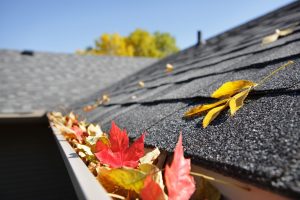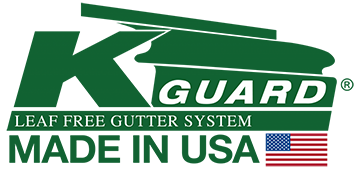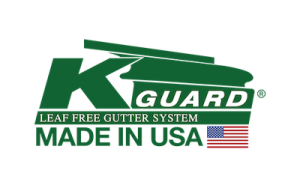 Gutters play a key role in protecting the siding and foundation of your home. The gutters help to collect water as it falls from the roof and transports the water to a downspout, where it can be discarded away from your home. This keeps excess water away from the foundation and siding of your home. This can help to prevent soil erosion problems that can lead to sinking or shifting foundations, or problems associated with flooding in crawl spaces and basements. Keeping water away from the siding of your home helps to prevent rot and mold issues as well. While gutters are extremely important, they cannot do their job if they are clogged. Learning the key signs of a clogged gutter can help you to prevent that problem.
Gutters play a key role in protecting the siding and foundation of your home. The gutters help to collect water as it falls from the roof and transports the water to a downspout, where it can be discarded away from your home. This keeps excess water away from the foundation and siding of your home. This can help to prevent soil erosion problems that can lead to sinking or shifting foundations, or problems associated with flooding in crawl spaces and basements. Keeping water away from the siding of your home helps to prevent rot and mold issues as well. While gutters are extremely important, they cannot do their job if they are clogged. Learning the key signs of a clogged gutter can help you to prevent that problem.
Water is Spilling Over the Edges of Your Gutters
The number one sign that your gutters are clogged is that water is spilling over the sides or edges of your gutters. The next time it is raining, step outside for a minute and look at your gutters. Do you notice water sloshing over the edges of the gutter and falling out? If so, your gutters are likely clogged. Clogs in the gutter system prevent water from flowing through the gutter channels as it should. When it rains, water builds up in the channel and has nowhere to go but over the edge.
Plants Are Growing in Your Gutters
Another common sign of clogged gutters is plants sprouting or growing in your gutters. You should not notice any type of growth peeking out from your gutters. However, if water is sitting in the trough, along with dirt and a single seed, one or more plants may begin to sprout. It is important to remove the growth quickly, as the root system can damage the gutter system, and the plant itself can obstruct water from properly flowing through the gutter system as it is designed to do.
Water is Not Coming Down the Downspout
One of the top misconceptions about clogged gutters is that if you do not notice water spilling over the edges of the gutter system, the gutters are not clogged. This is not true. Gutter systems can hold a lot of water, and in some cases, your gutters may be clogged, but there may not be enough water present to flow over the edges of the gutter. When it rains, step outside and watch the gutters. Does the rainwater actually come out the downspout? If you notice very little to no water coming out of the downspout, you may have a clog in the downspout or within your gutters.
Your Gutters Are Starting to Sag
One of the dangers associated with having clogged gutters is that the gutters can become so full of debris and water that the weight of these items starts to damage the gutters. Typically, before the seams of your gutters start to split or separate, you will notice that they start to sag from the weight of excess water and/or debris. This is a clear indication that your gutters are full and that they need to be cleaned. If you do not do so in a timely manner, the gutters may split at the seams, and then you will need to install new gutters.
Pests Are Hanging Out In or Around Your Gutters
One of the lesser-known signs that you may have clogged gutters is the appearance of pests by your gutters. You may notice the pests actually hanging out in the gutter, or see them hanging out on the edge of your roof. The types of pests may range from birds to small rodents and squirrels to insects. Clogged gutters are attractive to pests for a few reasons. First, clogged gutters may have small amounts of water in them that the pest can drink from or use to bathe in. Secondly, clogged gutters often have debris in them, such as leaves, sticks and mud. A pest can use those items to make a nest or shield themselves from predators. If you notice pests hanging out in or near your gutters, you may have clogged gutters.
Stain Marks Are Present On the Siding By Your Gutters
The final common sign that your gutters are clogged is stain marks on the siding underneath your gutters. If water is sitting in the gutters with debris, that water may become very dirty. As the water slowly seeps out of the gutters, it may start to stain the side of your home, leaving behind brown or black stains. Additionally, sitting water in a gutter channel can lead to rust issues. If the gutters rust, you may notice brown or red rust stains on the siding of your home. Rusted gutters should be replaced to ensure they can hold and transport water and to prevent staining on your home’s siding.
Gutters are a vital part of protecting your home, but traditional gutters need to be cleaned regularly to ensure they function properly. If you do not have the time to regularly clean your gutters, there is a solution that may help you. Installing gutter guards by K Guard is a great way to reduce the amount of debris that winds up in your gutters, in turn, reducing the frequency in which they need to be cleaned. Gutter guards cover a large portion of the gutter, allowing only water to seep into the gutters, and not items such as leaves and sticks. If you are ready to reduce the frequency in which you need to clean your gutters, reach out to us at K Guard to learn more.

